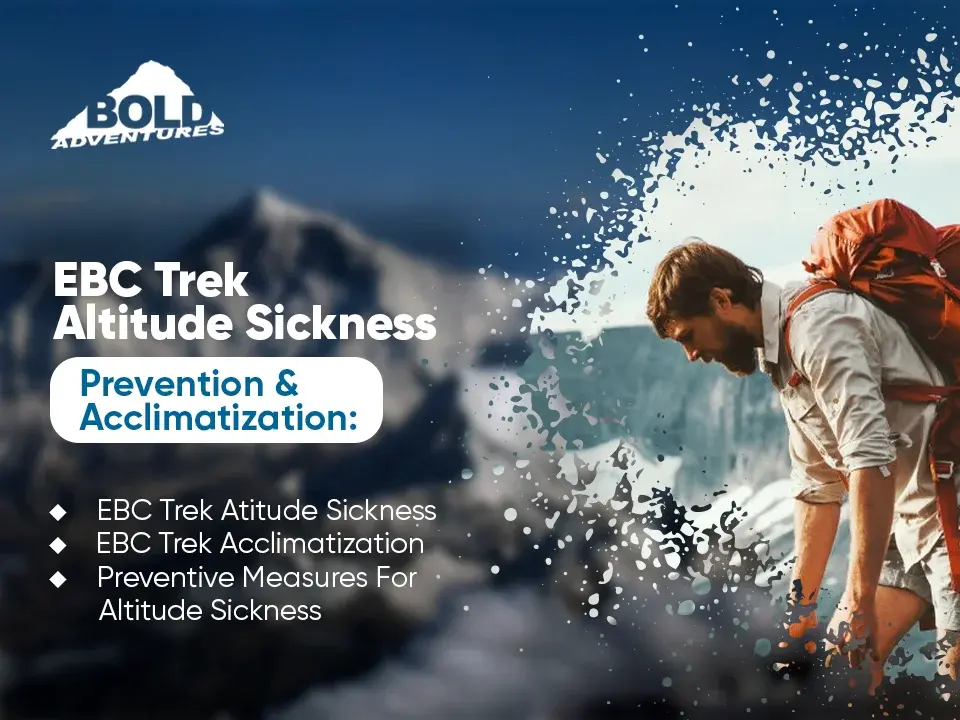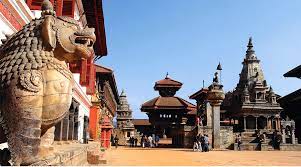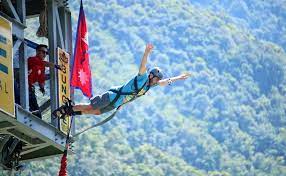Embark on a breathtaking adventure to the Everest Base Camp trek, where the magnificence of the world’s highest peaks awaits. But amidst the awe-inspiring beauty, there’s a challenge that awaits trekkers: Everest base camp altitude sickness.
Don’t worry, though! Our guide is here to equip you with the knowledge and strategies needed to conquer this terrifying issue. Whether you’re a seasoned adventurer or a first-time explorer, understanding the causes, recognizing the symptoms, and knowing how to prevent Everest base camp altitude sickness is vital.
So, lace up your boots, take a deep breath of mountain air, and let’s unravel the secrets to an unforgettable journey while keeping Everest base camp altitude sickness at bay.
EBC Trek Acclimatization
Acclimatization plays a vital role in the Everest Base Camp trek, especially considering the altitude challenges that climbers may face. With the base camp located at a staggering 5,364 meters (17,598 feet), altitude sickness becomes a significant concern. To combat this, it is crucial to allow sufficient time for Everest base camp acclimatization.
One effective acclimatization strategy is to spend three nights in Namche Bazaar, which is situated at an elevation of 3,440 meters (11,300 feet). Namche Bazaar serves as a crucial checkpoint on the way up the trail, providing trekkers with an opportunity to adjust to the increasing altitude. This extended stay allows the body to adapt gradually to the thinning air, reducing the risk of altitude illness, including Acute Mountain Sickness (AMS), High-Altitude Pulmonary Edema (HAPE), and High-Altitude Cerebral Edema (HACE).
By spending three nights in Namche Bazaar, trekkers give themselves a better chance of a safe and successful journey. This additional time at this critical height allows the body to acclimate and build the red blood cells required to cope with higher altitudes. It also allows individuals to monitor their physical condition and ensure they are not showing any signs of altitude sickness before proceeding further.
During these acclimatization days, trekkers can explore the charming village of Namche Bazaar and its surroundings. They can indulge in leisurely walks, visit the local markets, or hike to nearby viewpoints or, such as Everest View Point as there are many places to visit while trekking to the Everest base camp. Not only does this provide a chance to immerse oneself in the breathtaking natural beauty and stunning mountain views, but it also serves as a welcome respite from the challenges of the trek.
In addition to the extended stay in Namche Bazaar, other Everest base camp acclimatization techniques are also crucial. Staying hydrated by drinking plenty of fluids, including herbal tea, water, and soup, is essential to aid the body’s adjustment to the altitude. Engaging in deep breathing exercises helps optimize oxygen intake and transfer in the body. Furthermore, maintaining a balanced diet, including foods rich in carbohydrates and consuming garlic soup, can counter altitude illness.
It is important to note that Everest Base Camp trek organizers and guides provide valuable instructions and guidance on effective acclimatization practices. Following their advice and participating in recommended activities can greatly contribute to a safe and enjoyable trekking experience.
Acclimatization holds immense significance on the Everest Base Camp trek, particularly in mitigating the risk of Everest base camp altitude sickness. Allocating three nights in Namche Bazaar allows trekkers to gradually adapt to the increasing altitude, ensuring their bodies have ample time to adjust and minimize the chances of altitude-related illnesses. By implementing proper acclimatization strategies, such as extended stays, staying hydrated, practicing deep breathing exercises, and consuming a balanced diet, individuals can enhance their chances of completing the trek successfully while also appreciating the awe-inspiring beauty of the Everest region.
What Is Altitude Sickness?
As you set foot on the incredible journey to Everest Base Camp, the breathtaking heights present you with a remarkable challenge: altitude sickness. This condition, also known as acute mountain sickness (AMS), can strike when you ascend to the awe-inspiring altitude of 5,300 meters.
The thin air and reduced oxygen levels at these lofty heights put your body’s adaptability to the ultimate test. Altitude sickness reveals itself through a spectrum of symptoms, ranging from mild inconveniences like headaches, breathlessness, and queasiness, to more severe warning signs that hint at the presence of AMS.
Picture persistent dry coughs, fevers, fluid in the lungs, or even swelling of the brain, unleashing relentless headaches, intense bouts of vomiting, unsteadiness, dizziness, numbness, and in rare cases, loss of consciousness.
Recognizing the telltale signs of altitude sickness isn’t just essential, it empowers you to take the necessary precautions, prepare diligently, and acclimatize effectively. So, as you embark on this extraordinary expedition to Everest Base Camp, equip yourself with the knowledge to minimize the likelihood of encountering Everest base camp altitude sickness, ensuring your safety and well-being throughout this awe-inspiring adventure.
What Are The Causes Of Altitude Sickness?
Altitude sickness, that unwelcome companion on your epic journey to Everest Base Camp, arises from various factors that disrupt your body’s ability to adapt to breathtaking heights. One of the main culprits is the temptation to ascend too quickly, denying your body the precious time it needs to acclimatize to thin air and reduced oxygen levels.
Dehydration, a notorious troublemaker, can also wreak havoc on your body’s performance at higher altitudes. And let’s not forget the mischievous duo of alcohol indulgence and sleep deprivation, which have a knack for amplifying the symptoms of altitude sickness.
But fear not! By unraveling the causes behind this formidable condition, you hold the key to taking proactive measures, ensuring a safer and more exhilarating trek to Everest Base Camp. So, let your body embrace the gradual acclimatization it craves and bid farewell to the daunting shadow of severe altitude sickness symptoms. Your adventure awaits, and with careful preparation, you’ll conquer those lofty heights with confidence and ease.
Symptoms Of Altitude Sickness
Altitude sickness presents a symphony of symptoms, each unique in its impact on your adventure to Everest Base Camp. As you ascend to greater heights, mild discomforts like headaches and slight queasiness serve as gentle reminders of the thin air and reduced oxygen levels surrounding you. However, it’s important to note that certain sensations, such as pins and needles, can arise from acclimatization medications like Diamox.
In the face of altitude challenges, staying vigilant for more severe symptoms is key, as they may indicate the presence of acute mountain sickness (AMS). An ongoing dry cough or fever could be signs of fluid in the lungs, a dangerous complication requiring immediate attention. Likewise, a persistent headache resistant to painkillers and hydration, accompanied by severe vomiting, clumsiness, dizziness, numbness, or even loss of consciousness, may signal brain swelling—an alarming condition associated with AMS.
Should you encounter these severe symptoms, swift action is crucial. Descending by at least 2,000 feet and seeking medical assistance becomes imperative for your well-being. During your remarkable journey to Everest Base Camp, the expedition organizers will extend their support, arranging necessary transportation, be it a sturdy jeep or an urgent helicopter rescue. By promptly recognizing and addressing these symptoms, you safeguard your safety, enabling you to continue your trek with renewed confidence and tranquility.
Preventive Measures For Altitude Sickness
When embarking on an exhilarating adventure to higher altitudes like Everest Base Camp, preventing altitude sickness becomes absolutely crucial. By embracing these essential tips and tricks, you’ll not only minimize the risk of altitude sickness but also ensure an unforgettable and worry-free trek.
First things first, take it slow and steady as you ascend. Give your body the time it needs to adapt to the changing altitude by avoiding sudden climbs. Instead, opt for a gradual increase in elevation over a couple of days. This way, you’ll allow your body to gracefully adjust to the thinner air and lower oxygen levels, keeping altitude sickness at bay.
Fueling your body with a well-rounded diet is another vital aspect of altitude sickness prevention. Load up on extra carbs to provide your body with the energy it craves at higher altitudes. Make sure to pack your backpack with an array of wholesome snacks brimming with whole grains, giving you the necessary fuel to conquer every step of your trek.
Learn More:
Everest Base Camp Trek Packing List
Hydration is key in combating altitude sickness. Keep yourself properly hydrated throughout your climb by taking regular sips of water. The dry mountain air can deplete your body’s water levels faster, so aim to drink at least three to four liters of water per day. By maintaining optimal hydration, you’ll keep those pesky symptoms at bay and ensure your body functions at its best.
Now, when it comes to indulging, it’s best to steer clear of alcohol, cigarettes, and sleeping pills. These sneaky culprits can exacerbate altitude sickness symptoms and interfere with your body’s adjustment process. If you’re longing for a celebratory drink, hold off for at least 48 hours after reaching higher altitudes to give your body the necessary time to adapt before raising a toast to your epic adventure.
Remember, this is your trek, so listen to your body and take it easy. Avoid pushing yourself too hard or overexerting yourself. Find a comfortable pace that suits you and allows for a seamless acclimatization process. Grant yourself the luxury of rest and recovery, especially if you plan on conquering heights beyond the 1,000-foot mark in a single day. Embrace the journey, absorb the stunning surroundings, and let your body adjust to its own rhythm.
When it’s time to catch some much-needed rest, consider descending to a lower altitude for a rejuvenating night’s sleep. Altitude sickness symptoms often rear their ugly heads during rest, so descending to a more forgiving elevation will provide relief and enhance the quality of your slumber. Craft your itinerary thoughtfully, ensuring you have ample rest periods at lower altitudes to recharge before continuing your upward ascent.
In some cases, your healthcare provider may recommend medication to prevent altitude sickness. Acetazolamide, affectionately known as Diamox, can be a helpful ally in this endeavor. Typically taken a couple of days prior to your ascent and continued throughout your trek, this trusty medication aids in warding off altitude sickness. Remember, always consult your healthcare professional for personalized guidance and a proper prescription before embarking on your grand adventure.
While these preventive measures significantly decrease the likelihood of altitude sickness, it’s crucial to remain vigilant. Stay in tune with your body and be on the lookout for any symptoms that may arise. Should persistent headaches, difficulty breathing, or coordination troubles emerge, don’t hesitate to descend to a lower altitude immediately and seek the necessary medical assistance.
By wholeheartedly embracing these essential guidelines, you’ll not only safeguard yourself against altitude sickness but also unlock the full potential of your extraordinary journey to Everest Base Camp. Cherish every single moment, allow your body to adjust naturally, and savor the breathtaking splendor of the Himalayas with unwavering confidence and serene tranquility. Your adventure awaits!
Also, check out:
Fitness Level Required For Everest Base Camp Trek
Conclusion
We sincerely hope that this article hasn’t discouraged you from embarking on the remarkable adventure of the Everest Base Camp (EBC) Trek. While it’s important to acknowledge the potential Everest base camp difficulty, it’s equally crucial to acknowledge the incredible rewards that await you on this once-in-a-lifetime journey.
Every year, numerous trekkers set out to conquer the Everest Region, and the majority of them return with a profound sense of happiness, unforgettable memories deeply etched in their minds, stunning photos to share with loved ones, and lasting friendships that endure for years. While there might be some physical discomfort along the way, these become cherished reminders of the extraordinary achievement you’ve accomplished.
The Everest Region is an absolute marvel, unlike any other place on Earth. It offers experiences that are beyond comparison. It is a convergence of awe-inspiring mountains, vibrant cultures, and the indomitable human spirit. Regardless of when you decide to embark on this adventure, be assured that the trail will unveil awe-inspiring sights that leave you speechless and touch your soul in unimaginable ways.
If you have any doubts about your ability to trek at high altitudes, please feel free to contact us at Bold Adventures. We have guided numerous individuals from diverse backgrounds and countries, helping them successfully reach Everest Base Camp. We are here to provide unwavering support and invaluable advice, and can even suggest alternative treks(Everest three pass trek, Gokyo Lakes Trek, Everest base camp trek via Gokyo Lakes) and tours if needed.
Always remember, the journey to Everest Base Camp is an opportunity for personal growth, self-discovery, and a profound connection with the extraordinary beauty of nature. With proper preparation, steadfast support, and a positive mindset, you can overcome any challenges that come your way and create memories that will nourish your spirit and enrich your life for years to come. Embrace the adventure that awaits you with open arms!
Also, Read




